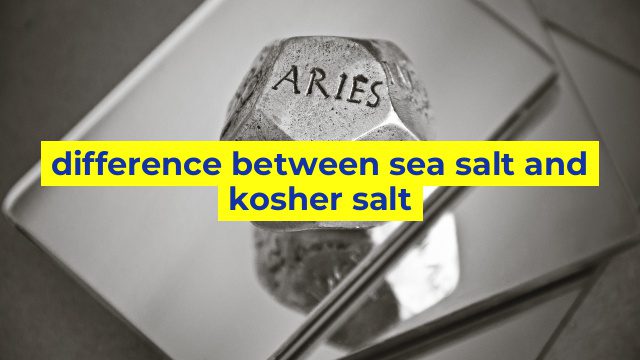The Difference Between Sea Salt and Kosher Salt
When it comes to salt, there are many varieties available in the market. Two of the most popular types are sea salt and kosher salt. Though they may look and taste similar, there are significant differences between them.
What is Sea Salt?
Sea salt is formed by evaporating seawater. The harvested salt crystals vary in size and shape, which gives it a unique flavor and texture. Sea salt comes in different colors, such as white, pink, gray, and black.
What is Kosher Salt?
Kosher salt is a type of coarse-grained salt used for koshering meat, which is a process to remove blood from the meat according to Jewish dietary laws. Kosher salt is less salty than table salt because of its larger crystal size, but it still contains the same amount of sodium.
Differences Between Sea Salt and Kosher Salt
1. Texture: Sea salt has a coarser texture than kosher salt, making it ideal for adding a crunchy texture to dishes. Kosher salt, on the other hand, is finer and dissolves quickly, making it ideal for seasoning and brining.
2. Taste: Sea salt is known for having a distinct, briny flavor that is missing in kosher salt. Kosher salt is more neutral in taste and brings out the flavor of the food it is sprinkled on.
3. Mineral Content: Sea salt contains more minerals like magnesium, calcium, and potassium than kosher salt, which is why it is known to be healthier.
Which One to Use for Cooking?
Both sea salt and kosher salt are great choices for cooking, and the choice depends on the type of dish being prepared. If a recipe calls for a specific type of salt, it is best to stick to it. If no salt type is specified, either type can be used. However, it is important to remember that sea salt has a stronger flavor profile, so less is required while cooking.
In conclusion, while both sea salt and kosher salt are essential ingredients used in cooking, they have some differences in texture, taste, and mineral content. Understanding their differences allows you to use them in the most appropriate way, enhancing the flavor profile of your dishes with every sprinkle.
Table difference between sea salt and kosher salt
| Property | Sea Salt | Kosher Salt |
|---|---|---|
| Source | Derived from evaporated ocean water | Mined from salt deposits, often processed to remove impurities |
| Texture | Coarse and chunky | Coarse but less chunky than sea salt |
| Flavor | Briny and slightly sweet | Milder and cleaner, with no extra minerals or flavors |
| Usage | Great for finishing dishes, sprinkling on top of meats and veggies, or rimming cocktail glasses | Good for everyday cooking and baking, dissolves quickly and evenly |
| Price | Usually more expensive than kosher salt | Typically less expensive than sea salt |
